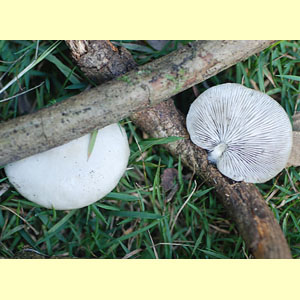
images/Conchomyces_bursiformis/Conchomyces_bursiformis_NK_DSC_0304.JPG
Small to large agaric, growing on wood, with a white spore print. Pileus variable in colour from white, to generally pale tints of brown, green or grey, strongly hygrophanous, not viscid. Lamellae adnexed, subdecurrent or decurrent. Stipe excentric or usually lateral. Partial veil remnants absent. Spores hyaline, dextrinoid or non-amyloid, warty or spinose; germ pore absent. Cheilocystidia and pleurocystidia present, the latter thick-walled. Lamellar trama regular or interwoven. Pileipellis a trichoderm or a hymeniderm. Clamp connections present or absent.
The white spore print and hyaline spores readily separate
Conchomyces from brown-spored genera with a lateral or absent stipe such as
Crepidotus. Among pleurotoid agarics (white-spored with a lateral stipe),
Hohenbuehelia is most similar (especially in the presence of thick-walled cystidia), but that genus has smooth (rather than spinose) spores. In
Lentinellus, some species of which are pleurotoid, the lamellae edges are serrate and the spores have amyloid ornamentation. All other pleurotoid agarics (see under
Pleurotus) have smooth spores.
Conchomyces Overeem, in Heyne, Bull. Jard. Bot. Buitenzorg, sér. 3, 9: 19 (1927).
One species: Conchomyces bursiformis (with numerous synonyms).
Conchomyces bursiformis (Berk.) E.Horak, Sydowia 34: 110 (1981).
W.A., Qld, N.S.W., Vic. and Tas. (and possibly also N.T.). Also found in Chile, New Caledonia, New Zealand, New Guinea, Indonesia, and as an exotic in the United Kingdom.
In native forests, including cool-temperate rainforest.
On wood or tree ferns.
Saprotrophic.
Fuhrer, B. (2005),
A Field Guide to Australian Fungi. Bloomings Books, Hawthorn. [
Description and
Illustration of
C. bursiformis]
Fuhrer, B. & Robinson, R. (1992), Rainforest Fungi of Tasmania and South-east Australia. CSIRO Press, East Melbourne. [Illustration of C. bursiformis]
Hobart, C. (2003), Exotic mushroom in an urban setting, Field Mycology 4: 84–85. [Illustration of C. bursiformis from United Kingdom]
Horak, E. (1981b), Conchomyces v. Overeem - an independent genus within the Agaricales?, Sydowia 34: 109–114. [Description, B&W Illustration and Microcharacters of C. bursiformis]
Petersen, R.H. & McCleneghan, S.C. (1995), Mating systems of antipodal agarics: an unreported taxon and range extensions, New Zealand J. Bot. 33: 93–98. [Description, B&W Illustration and Microcharacters of C. bursiformis]
Reid, D.A. (1963), New or interesting records of Australasian Basidiomycetes: V, Kew Bull. 17: 267–308. [Description and Microcharacters of C. bursiformis]
Singer, R. (1969), Mycoflora australis, Beih. Nova Hedwigia 29: 1–405. [Description of C. bursiformis as Hohenbuehelia dimorphocystis]
_AH_20_sml.jpg)
